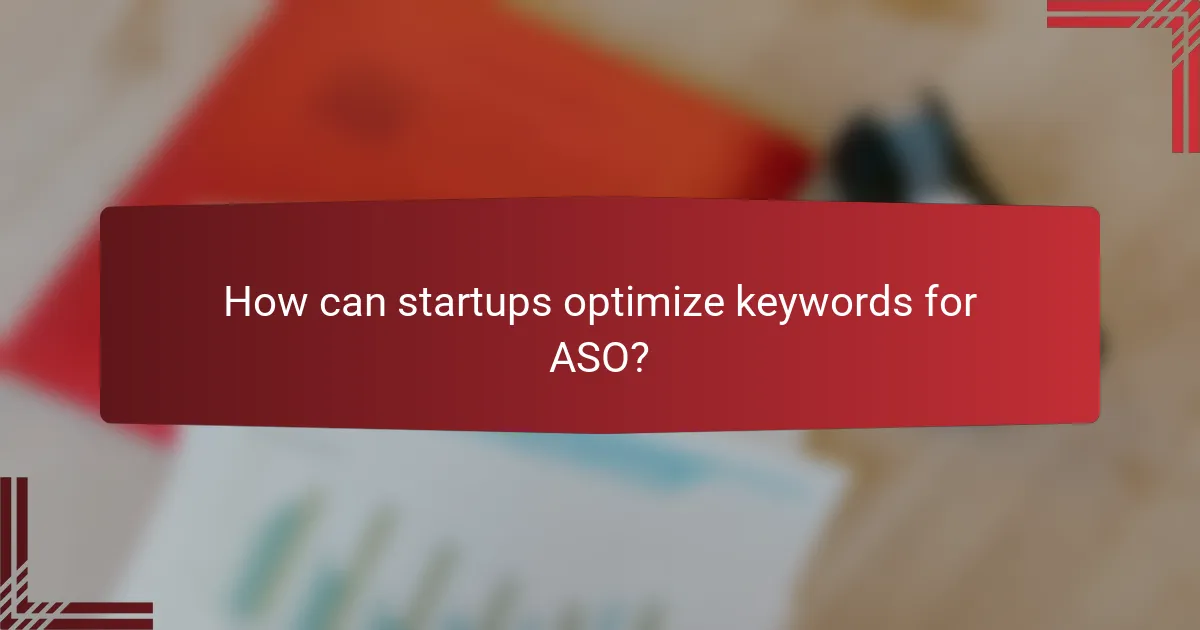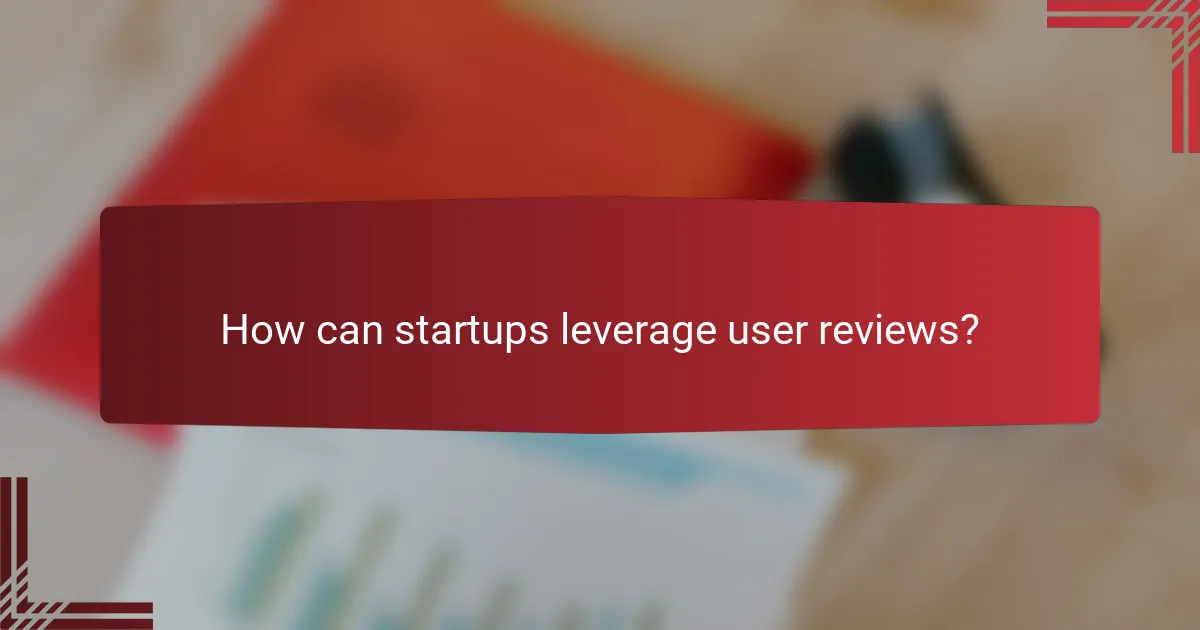For startups looking to enhance their app’s visibility without breaking the bank, budget-friendly App Store Optimization (ASO) techniques can be highly effective. By focusing on keyword optimization, improving app visuals, managing user reviews, and leveraging social media and influencer partnerships, startups can significantly boost downloads and user engagement. These strategies not only maximize exposure but also foster a strong connection with potential users.

What budget-friendly ASO techniques can startups use?
Startups can leverage several budget-friendly App Store Optimization (ASO) techniques to improve their app’s visibility and downloads without significant financial investment. Focusing on keyword optimization, enhancing app visuals, managing user reviews, promoting on social media, and forming influencer partnerships can yield substantial results.
Keyword optimization
Keyword optimization involves researching and selecting relevant keywords that potential users might use to find your app. Start by identifying a mix of high-traffic and low-competition keywords to improve your app’s ranking in search results.
Utilize tools like Google Keyword Planner or App Annie to discover effective keywords. Incorporate these keywords naturally into your app title, description, and metadata, ensuring they align with user intent.
Avoid keyword stuffing, as it can lead to penalties. Instead, focus on a few strong keywords and variations to maintain clarity and relevance.
App store visuals enhancement
Enhancing your app store visuals is crucial for attracting potential users. High-quality screenshots, an engaging app icon, and an informative video can significantly impact conversion rates.
Use tools like Canva or Adobe Spark to create visually appealing graphics. Ensure that your visuals highlight key features and benefits of your app, and consider A/B testing different designs to see which performs best.
Keep in mind that visuals should be consistent with your brand identity and resonate with your target audience to maximize effectiveness.
User reviews management
Managing user reviews is essential for maintaining a positive app reputation. Encourage satisfied users to leave positive reviews while addressing negative feedback promptly and professionally.
Set up alerts for new reviews and respond to them within a few days. Acknowledge concerns, offer solutions, and express gratitude for positive feedback. This engagement can foster a loyal user base and improve your app’s ratings.
Consider implementing in-app prompts to request reviews after positive interactions, ensuring you ask at the right moment to maximize the likelihood of receiving favorable feedback.
Social media promotion
Social media promotion can effectively increase your app’s visibility at little to no cost. Create engaging content that showcases your app’s features and benefits, and share it across platforms like Facebook, Instagram, and Twitter.
Utilize hashtags relevant to your app’s niche to reach a broader audience. Engage with users by responding to comments and messages, and consider running contests or giveaways to encourage sharing and interaction.
Consistency is key; maintain a regular posting schedule to keep your audience engaged and informed about updates or new features.
Influencer partnerships
Forming partnerships with influencers can amplify your app’s reach without a hefty budget. Identify influencers in your app’s niche who have a genuine following and align with your brand values.
Reach out with a clear proposal, offering them free access to your app or a small commission for each download generated through their promotion. Ensure that the partnership feels authentic to their audience to maximize impact.
Track the performance of influencer campaigns to assess their effectiveness and adjust your strategy as needed for future collaborations.

How can startups optimize keywords for ASO?
Startups can optimize keywords for App Store Optimization (ASO) by focusing on relevant terms that potential users are likely to search for. This involves thorough research, targeting specific phrases, and analyzing competitors to enhance visibility and downloads.
Research using tools like App Annie
Utilizing tools such as App Annie can provide valuable insights into keyword performance and trends. These platforms allow startups to analyze app rankings, user reviews, and search volume, helping to identify high-potential keywords. Start by entering your app category and exploring the top-performing apps to gather keyword ideas.
Consider tracking keywords over time to understand shifts in user behavior and preferences. Regularly updating your keyword strategy based on these insights can significantly improve your app’s discoverability.
Long-tail keyword targeting
Long-tail keywords are specific phrases that typically have lower search volumes but higher conversion rates. Startups should focus on these keywords as they often face less competition and can attract a more targeted audience. For example, instead of targeting “fitness app,” consider “home workout fitness app for beginners.”
Incorporating long-tail keywords into your app title and description can enhance relevance and improve rankings. Aim for a mix of broad and long-tail keywords to balance visibility and specificity.
Competitor analysis
Analyzing competitors is crucial for identifying effective keywords and strategies in your niche. Start by examining the keywords used by top competitors in your category and noting their app descriptions and titles. This can reveal gaps in your own keyword strategy and highlight opportunities for differentiation.
Tools like Sensor Tower or Mobile Action can assist in competitor analysis by providing keyword rankings and performance metrics. Regularly revisiting this analysis helps ensure your app remains competitive and aligned with market trends.

What role do app visuals play in ASO?
App visuals are crucial in App Store Optimization (ASO) as they significantly influence user engagement and conversion rates. High-quality visuals can attract potential users, convey the app’s purpose, and enhance its perceived value.
Importance of app icons
App icons serve as the first impression for users browsing app stores. A well-designed icon should be visually appealing and reflective of the app’s functionality. Aim for simplicity and clarity, using bold colors and recognizable shapes to stand out among competitors.
Consider testing different icon designs to see which resonates best with your target audience. Tools like A/B testing can help determine the most effective icon, potentially increasing downloads by a notable margin.
Impact of screenshots
Screenshots provide a visual narrative of your app’s features and user interface. They should highlight key functionalities and showcase the app in action to give users a clear idea of what to expect. Use captions to guide viewers through the screenshots, emphasizing unique selling points.
Limit the number of screenshots to around five to avoid overwhelming potential users. Ensure they are high-resolution and optimized for both iOS and Android platforms, as each has different display requirements.
Video previews effectiveness
Video previews can significantly enhance user engagement by demonstrating the app’s capabilities in a dynamic format. A short, compelling video can capture attention quickly and convey complex features more effectively than static images.
Keep video previews under 30 seconds to maintain viewer interest. Focus on showcasing the app’s core functionalities and user experience, and consider including a call-to-action at the end to encourage downloads.

How can startups leverage user reviews?
Startups can leverage user reviews by actively encouraging positive feedback, responding to negative comments, and extracting valuable keyword insights. These strategies enhance app visibility, improve user engagement, and ultimately drive downloads.
Encouraging positive reviews
To encourage positive reviews, startups should create a seamless user experience that delights customers. This can include intuitive app design, responsive customer support, and regular updates based on user feedback.
Additionally, consider prompting users for reviews after they complete a positive action, such as making a purchase or achieving a milestone in the app. A simple in-app message or email request can significantly increase the likelihood of receiving favorable reviews.
Responding to negative feedback
Responding to negative feedback is crucial for maintaining a positive brand image. Startups should address complaints promptly and professionally, showing users that their opinions are valued. Acknowledging issues and providing solutions can turn a negative experience into a positive one.
It’s also beneficial to take the conversation offline when necessary, offering users a direct line of communication to resolve their concerns. This approach not only helps to mitigate damage but can also lead to improved user loyalty.
Using reviews for keyword insights
User reviews can provide valuable insights into keywords that resonate with your target audience. By analyzing the language and phrases used in reviews, startups can identify popular terms that can enhance their app store optimization (ASO) strategy.
Consider using tools to extract keywords from reviews and incorporate them into your app’s title, description, and metadata. This practice can improve search rankings and attract more users who are searching for specific features or solutions related to your app.

What are the best practices for social media promotion?
Effective social media promotion involves creating engaging content, utilizing targeted ads, and building a community around your brand. These strategies help startups increase visibility, attract users, and foster loyalty without requiring a large budget.
Creating engaging content
Engaging content is crucial for capturing the attention of your audience on social media. Focus on high-quality visuals, compelling stories, and interactive elements like polls or quizzes to encourage participation. Aim for a mix of formats, such as videos, infographics, and user-generated content, to keep your feed dynamic.
Consider using a content calendar to plan and schedule posts consistently. Regular posting helps maintain audience interest and can improve your visibility in social media algorithms. Aim for a frequency that is manageable, such as 3-5 posts per week, depending on your audience’s engagement levels.
Utilizing targeted ads
Targeted ads allow you to reach specific demographics that are most likely to be interested in your product. Platforms like Facebook and Instagram offer robust targeting options based on interests, behaviors, and location. Start with a modest budget, such as $5-$10 per day, to test different ad creatives and audiences.
Monitor the performance of your ads closely. Use metrics like click-through rates and conversion rates to determine which ads resonate best with your audience. Adjust your strategy based on these insights, reallocating budget to the best-performing ads to maximize your return on investment.
Building a community
Building a community around your brand fosters loyalty and encourages word-of-mouth promotion. Engage with your audience by responding to comments, asking for feedback, and creating opportunities for user interaction. Consider hosting live Q&A sessions or community challenges to deepen connections.
Leverage social media groups or forums related to your niche to connect with potential users. Share valuable content and insights to establish your brand as a trusted resource. This approach not only enhances your visibility but also positions your startup as an integral part of the community.

How can influencer partnerships enhance ASO?
Influencer partnerships can significantly boost App Store Optimization (ASO) by leveraging the influencer’s audience to increase visibility and credibility. By collaborating with influencers who align with your app’s target market, you can drive organic downloads and improve your app’s ranking in app stores.
Identifying relevant influencers
To effectively enhance ASO through influencer partnerships, start by identifying influencers who resonate with your target audience. Look for individuals who create content in your app’s niche and have a genuine connection with their followers.
Utilize social media platforms and influencer marketing tools to find potential partners. Focus on metrics such as engagement rates, audience demographics, and content relevance to ensure they align with your brand values and goals.
Consider micro-influencers, who typically have smaller but highly engaged audiences. Collaborating with them can often be more cost-effective and yield better results in terms of authentic engagement compared to larger influencers.

